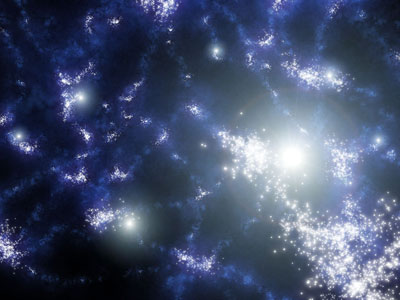Scientists using NASA's Spitzer Space Telescope say they have discovered light that may have emanated from the earliest objects in the universe

6.11.2005
By: Avi Blizovsky
An artist's rendering of the early universe.
Scientists using NASA's Spitzer Space Telescope say they have discovered light that may have emanated from the earliest objects in the universe. If this conclusion is confirmed, the observation revealed a flash from a period 13 billion years ago, after the embers of ash predicted by the Big Bang theory dissipated, thus ending a period of darkness and the universe was resurrected.
The light probably came from the first stars or perhaps from the hot gas that surrounded the first black holes. The team of scientists at NASA's Goddard Space Center in Maryland described the sighting as "seeing the glow of a distant city from an airplane at night. The light is so distant that it is difficult to separate it into individual objects.
According to the theory, space, time and matter were created 13.7 billion years ago in the Big Bang. Another 200 million years will pass until the first starlight. A ten-hour observation using Spitzer's infrared camera in the constellation Darko showed a pulse of infrared light, which has a lower energy than visible light. The team from Goddard says as mentioned that these are stars from the third constellation, a hypothetical type of stars that formed before all the others. (The population of stars of type 1 and 2 is named according to the order of discovery, and they consist of all the types of stars known to us in the night sky.)
The "third constellation" apparently contained stars composed of the elements hydrogen, helium and lithium only. These stars existed for a short period, estimated at only millions of years, and ended their lives after consuming all their hydrogen reserves.

Researchers from NASA believe that they have discovered remnants of radiation from stars that have already died, which were apparently "born" in the infancy stages of the universe. The study provides the first real evidence - although it is uncertain - of the first stars in the universe, which formed more than 13 billion years ago. The researchers believe that these stars formed the raw materials from which other stars, including the sun, later developed.
The "Big Bang", the cosmic explosion that scientists believe created the universe, probably occurred 13.7 billion years ago. About a hundred million years later, hydrogen atoms began to coalesce and burn, and this is how the first stars were formed. But until today it was not clear how exactly those stars looked and where they were found.
The researchers used the "Spitzer" telescope to take an infrared photo, a light that is not visible to the eye, of the stars and galaxies in a small part of the sky where the "Draco" system is located (top photo). Then they subtracted the radiation levels of all known stars and galaxies. According to them, the remaining background (bottom image) cannot be attributed to galaxies or "modern" stars, and it is possible that it is a glow that survived from the first stars in the universe. However, some astronomers expressed doubts about the research, claiming that the process of de-radiating stars and galaxies is not accurate enough and that the glow discovered is not a sign of life from the earliest stars.
For the press release of the Spitzer Telescope Institute

3 תגובות
It would be better if you took a picture of Pamela Anderson naked!@
You have nothing to do with life?
You're ugly